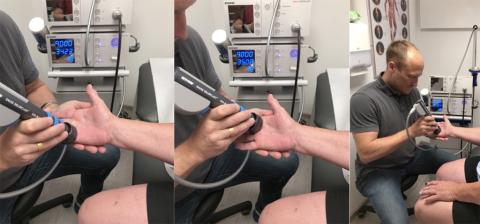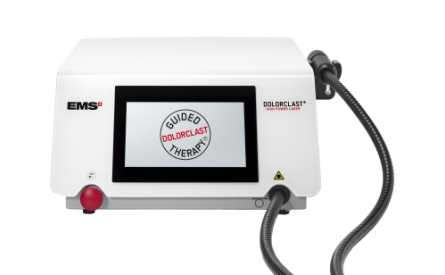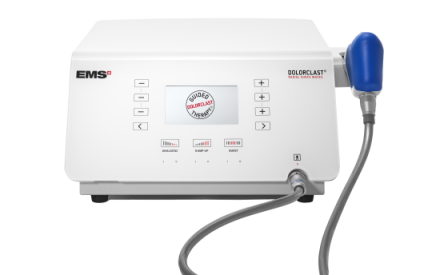
Guided DolorClast® Therapy for polyarticular arthritis of both hands
Chose the safe, quick and efficient treatment combination:
DolorClast® Radial Shock Waves & DolorClast® High Power Laser
In this specific case study, general practitioner and shock wave expert Peter Stiller (Augsburg, Germany) presents a patient suffering from polyarticular arthritis on both hands.
Peter Stiller is a shock wave therapy expert, has been using it extensively for the past few years and done multiple lectures on shock wave therapy for the Swiss DolorClast® Academy. For these reasons, he was chosen to be part of the group of specialists involved in the trials of the Guided DolorClast Therapy.
Caution, polyarticular arthritis of the hands is not an approved indication of the DolorClast Radial Shock Waves (only approved for knee osteoarthritis) and was treated by Peter Stiller under his own responsibility.
The case study discussed in this post appeared in in the German sports medicine network "Sportärztezeitung" highlighted an effective use of a combination of different instrumental therapies within a thorough treatment procedure. (Link).
This post examines the treatment approach of combining High Power Laser Therapy with Shock Wave therapy, as recommended by the Guided DolorClast® Therapy.

The material for this post was provided by the courtesy of Sportärztezeitung.
Click here for more information.
Focus on the patient
As recommended in the first step of the Guided DolorClast® Therapy, assess & engage, it is crucial to take into account every aspect of a patient's pathology, and to explain to them why they are suffering and how GDT will help them get better.
Looking for their medical background, assessing the chronicity of the pain and performing VAS scores will make the healing path much clearer and the patient will feel more involved in their recovery.
In this case study by Peter Stiller the patient is a 54-year-old woman with a chronic form (more than 3 months of pain) of polyarticular arthritis on both hands.
The diagnosis was established and confirmed relatively quickly, based on the patient's history of having both mother and grandmother suffering from this condition.
For Dr. Stiller's patient, this pathology is particularly disabling as it prevents her from carrying out her job as a secretary.
At her first appointment, she showed the main symptoms characteristic of the disease, such as pain and swelling of the finger joints. The pain is sharp during handshakes (VAS 9-10) and movements (VAS 6-8), and the extension of the fingers is simply impossible.
Various treatments had been tried before: “[…] NSAIDs, novaminsulfone drops, paracetamol, vitamin D, hot and cold hand baths, squeeze balls and rest” but “[she] was never without pain and the fingers were always swollen”.
In view of the ineffectiveness of these treatments, Dr. Stiller decided to try DolorClast Radial Shock Waves treatment as an alternative because "[he knew] of many cases of patients with polyarticular arthritis where ESWT had very often rapidly alleviated pain even when the polyarthritis had previously been refractory to treatment.” Alas, the discomfort caused by the shock wave treatment alone was such that it could not deliver the amount of energy required for optimal treatment.
However, a few months later he had the opportunity to test the DolorClast® High Power Laser in combination with the DolorClast® Radial Shock Waves and noticed that the combination makes the difference.

DolorClast® High Power Laser & DolorClast® Radial Shock Waves
Blind the pain to deliver the highest dose of energy
As mentioned earlier, before treating his patient with the combined approach of GDT, Dr. Peter Stiller had tried to use shock waves alone to treat his patient’s polyarticular arthritis.
He began the radial shock wave treatment with 5000 shocks at 0.3 bar on each hand, using a constant frequency of 20 Hz. The treatment was carried out weekly and by the 3rd session the patient could see an improvement in swelling and pain.
However, because of the discomfort experienced by the patient, they could not increase the pressure to more than 1.6 bar for the least affected hand and 1.2 bar for the most affected hand.
In order for a shock wave treatment to be optimal, it is fundamental to deliver the maximum energy density to the damaged tissue. Here, the working pressure was too low to achieve conclusive results, and the pain and swelling returned only three weeks after the end of the treatment.
This is where the DolorClast® High Power Laser comes into play. Not wishing to remain on this "failure", when Peter Stiller receives the new DolorClast® High Power Laser, he decides to try it on this patient. He uses the custom 3-minute GDT protocol with the hands-free mode on the areas most affected by the pathology.
The result? Dr. Stiller was able, 5 minutes after the treatment, to apply radial shock waves at a power of 2 bar without his patient experiencing any discomfort. The high-powered laser treatment allowed him to deliver a much higher dose of shock waves to his patient, promoting better healing.
“The effect […] immediately felt to be greater according to the patient and the pain relief induced by rESWT even markedly better than before.”
At the next treatment session, 5 weeks after the previous one, Peter Stiller tries to use the optimal treatment combination recommended by Guided DolorClast® Therapy, by leaving a one-hour break between the laser and the shock waves, which "enhanced the effects even more!" and allowed him to use the DolorClast® radial shock waves up to 2.5 bar, resulting in outstanding output:
The follow-up this time after 8 weeks […] was reason to celebrate, as the patient even after this length of time was still without pain and the hands were no longer swollen and were freely movable.
Why does it work?
DolorClast® High Power Laser
When designing the DolorClast® High Power Laser, the wavelength of 905 nm was specially chosen because it inhibits the nociceptors1.
Nociceptors are sensory neurons located at the nerve ending, that respond to potentially damaging stimuli by sending pain signals to the spinal cord and the brain. If they are inhibited, they will not send a signal and the patient won’t therefore feel pain anymore.
This powerful analgesic effect is already evident 5 minutes after the end of the treatment and lasts for up to 72 hours after the treatment.
1MEZAWA, S. et. Al, Archives of oral biology, 1988, vol. 33,9.
DolorClast® Radial Shock Waves
Shock wave therapy allows the expression of growth factors (PCNA, eNOS VEGF)1, making allowing for the formation of new blood vessels (angiogenesis) in tissues with blood supplies. This increased blood circulation fosters a faster healing of the treated tissues1.
Moreover, shock wave therapy activates mesenchymal stem cells2, which increases the formation of new cells for the regeneration of the injured tissues.
1HOFMAN et al., J Trauma / CONTALDO ET AL., Microvasc Res 2012, 84:24:-33 / KIRSCH ET AL., J Surg Res 2016; 201:440-445
2WANG CJ, ISMST Newsletter 2006, Vol 1, Issue 1
Improved clinical outcomes
The combined use of laser therapy and shock wave therapy enabled this patient to regain the freedom of movement that her pathology had taken away from her. She did not have to resort to the more invasive alternative methods with major side effects such as topical or oral cortisone, high doses of non-inflammatory drugs, and antimetabolite treatment.
With Guided DolorClast Therapy, treat your patients quickly, efficiently, and safely!


